Earlier this month, Zack Wheeler signed with the Philadelphia Phillies. The general consensus has been that Wheeler signed for more than expected, although it’s also true that the consensus for most of the starting pitching signings has been that they signed for more than expected. To be honest, I’m not convinced that the Phillies didn’t get a bargain. Even as is, Wheeler has been about a 3.70 ERA talent, and yet, there’s plenty of room to grow. The Phillies have even told him that they see some Gerrit Cole in him.
Of course, Cole is quite an extreme example, but I don’t think it’s a bad comparison. At all. Now, Cole has a fastball that is head and shoulders above the rest of the league, but it hasn’t always been that way. We’ll come back to Wheeler, but let’s take a look at Cole before he landed on the Houston Astros.
Cole’s whiffs heat map, from 2013 to 2017:
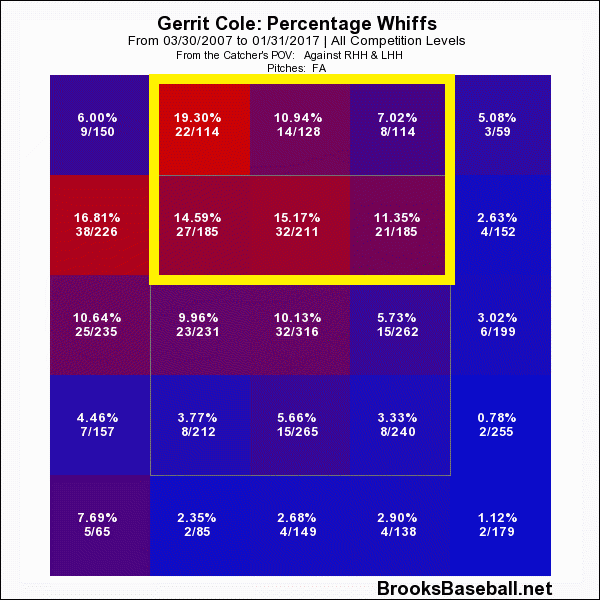
Now clearly, Cole has always been pretty solid at the top of the zone, but this doesn’t look like the heat map of the best fastball in the league. Here, I’ve calculated that, within the yellow box, Cole whiffs hitters 13.23% of the time. Not bad! Now let’s compare this to Wheeler.
Wheeler’s whiffs heat map, from 2013 to 2019:
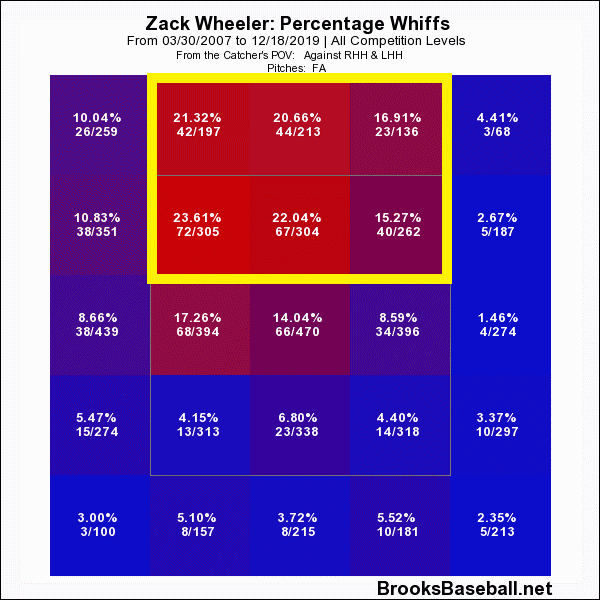
You may notice rather quickly that that’s actually significantly better than Cole’s pre-Astros whiff percentages. Wheeler’s whiff rate within the yellow box is 20.32%, a bump of about 7 percentage points over pre-Astros Cole. That’s really, really good.
Cole, of course, would go on to do this (his percentage whiffs during his time with the Astros):
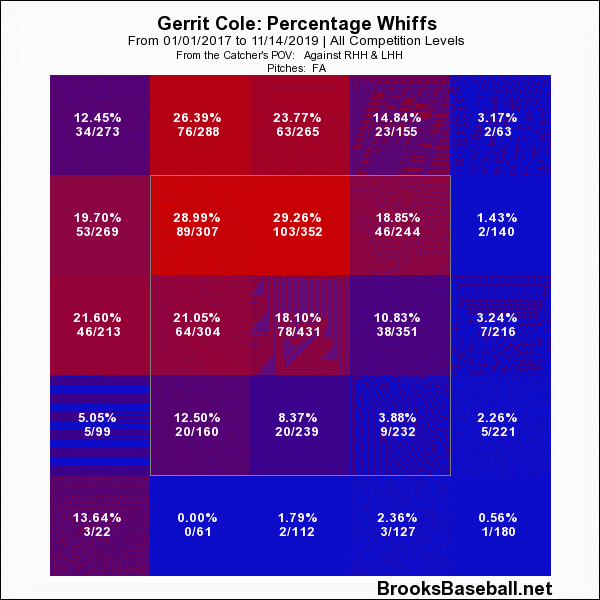
Bananas! Cole is bananas. The reason why he’s bananas is because he has a fastball that has a high spin rate and velocity, is made up of mostly active spin (i.e., nearly 100% backspin), and he throws it at the top of the zone. There are probably tweaks that Cole and the Astros made that we don’t know about (especially with his spin rate), but one we do know about is that they had him elevate his fastball.
Here’s Cole’s vertical fastball location, from 2013 to 2019:
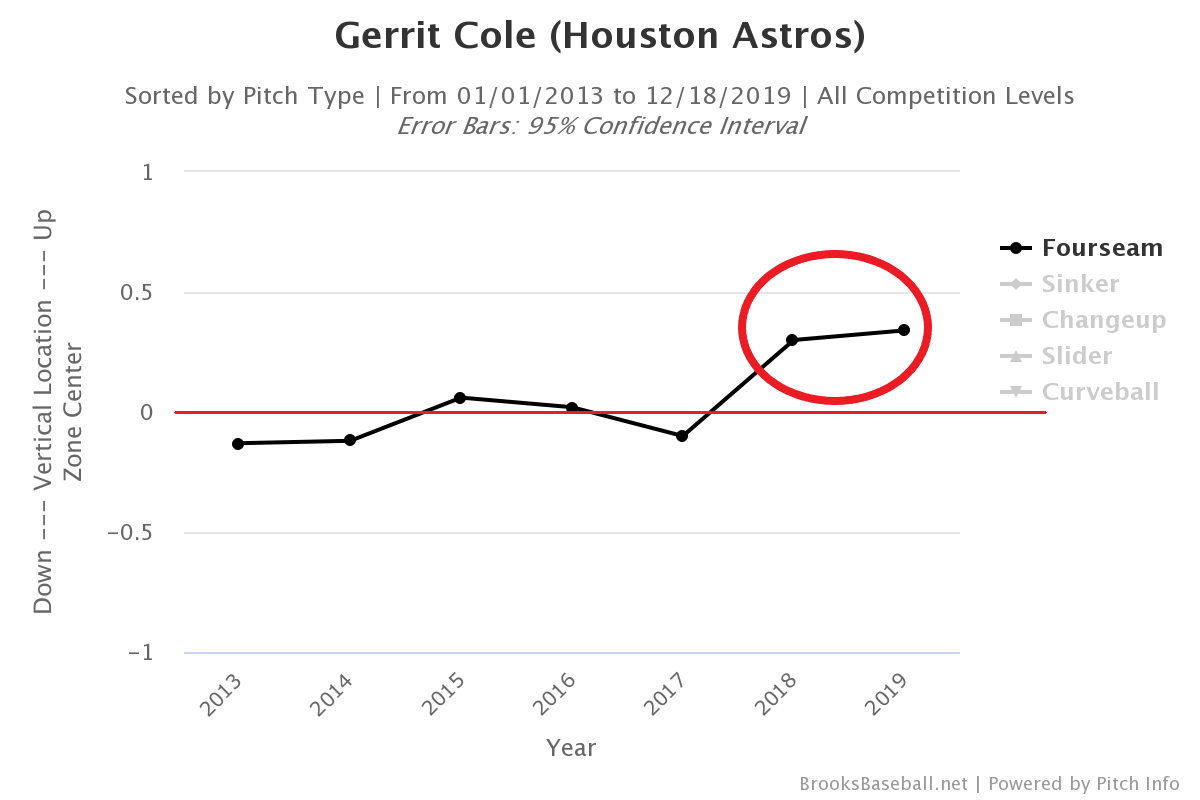
The red line signifies the vertical-middle of the strike zone, while the red circle indicates Cole’s tenure with the Astros. With the Pirates, his fastball’s location more or less averaged the middle of the strike zone—at least vertically. Then, with the Astros, he really started to elevate it. Of course, this is kind of common knowledge at this point. This isn’t all that different from what Wheeler has going on right now, either.
Now let’s compare pre-Astros Cole and Wheeler’s vertical fastball location:
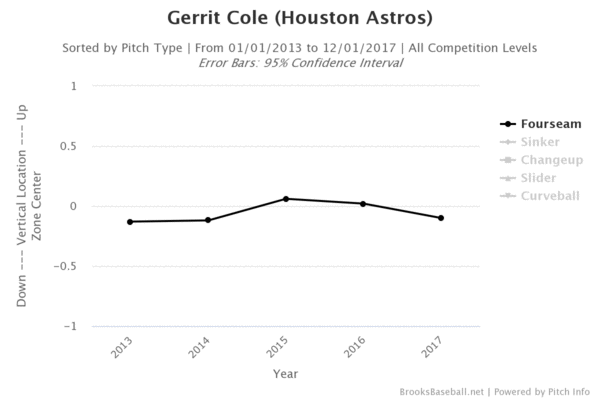
It’s actually quite shocking how similarly they implemented their fastballs. In terms of four-seam fastball use, Wheeler is pretty much exactly tracking the progression of Cole’s career. Now that he’s on a new team that has already made the comparison to Cole and talked about how they can get the most out of him, I would be highly, highly surprised if we didn’t see Wheeler follow suit with Cole and start to elevate his four-seam fastball. The Phillies coaching staff has been shown to propose such an approach to their pitchers—Zach Eflin followed their suggestions of throwing high fastballs before abandoning the approach after a few rough outings. While Chris Young has been ousted as their pitching coach, Bryan Price has taken over the helm and is high on analytics and building an approach suited to the individual pitcher. That bodes well for Wheeler.
Since his fastball will be the key to his success, let’s remember that, aside from his slider, Cole’s secondaries weren’t all that special before. Let’s take a look at how Cole was trending before the Astros got ahold of him.
Cole’s swinging-strike percentage, by pitch, from 2013 to 2017:
| Four-seam | Sinker | Slider | Curveball | Changeup | |
|---|---|---|---|---|---|
| 2013 | 5.6% | 5.5% | 15.4% | 19.9% | 13.5% |
| 2014 | 6.1% | 6.0% | 19.7% | 14.3% | 13.6% |
| 2015 | 7.2% | 5.7% | 20.3% | 13.0% | 5.0% |
| 2016 | 6.4% | 4.4% | 15.5% | 14.7% | 7.8% |
| 2017 | 8.3% | 3.9% | 17.0% | 9.0% | 11.1% |
| 2018 | 13.8% | 4.1% | 18.7% | 12.1% | 12.3% |
| 2019 | 16.7% | 0.0% | 21.1% | 10.8% | 18.6% |
If we think of 15% as our (mostly arbitrary) threshold here, then we can see that Cole’s slider has always been a weapon. The same can’t really be said about his other offerings—although his curveball and changeup are certainly solid pitches themselves—but we can clearly see that his sinker has always been an inferior pitch to his others, by whiffs.
If you look at Wheeler’s career pitch splits, you’ll find that they’re nothing to write home about, for the most part, but you could have said the same thing about Cole.
Here’s Cole (2013-2017) and Wheeler’s (2013-2019) career pitch-type swinging-strike rates:
| Four-seam | Sinker | Slider | Curveball | Changeup | Splitter | |
|---|---|---|---|---|---|---|
| Wheeler | 10.9% | 8.1% | 13.6% | 12.4% | 10.7% | 15.8% |
| Cole | 7.4% | 7.2% | 18.8% | 13.3% | 11.2% |
Across the board, we see similarities between the two. You can see that, ignoring Cole’s past two years, Wheeler has had the superior fastball. Cole has the superior slider, but then Wheeler has the splitter to offset the difference there.
They’re comparable by pitch value, too:
| Four-seam | Sinker | Slider | Curveball | Changeup | Splitter | |
|---|---|---|---|---|---|---|
| Wheeler | 43.9 | 0.2 | 11.7 | 1.8 | -8.3 | 0.9 |
| Cole | 32.0 | 4.7 | 10.7 | 1.2 | -0.4 |
Although, in fairness, Cole saw his fastball spin rate jump from about 2,150 with the Pirates to 2,400 with the Astros in 2018, and then over 2,500 in 2019. Spin rate is a pretty stable trait, and so it’s unlikely that we’ll see Wheeler improve his spin rate unless he sticks his arm elbow-deep into a vat of pine tar. Nonetheless, this makes it more difficult to make an apples-to-apples comparison since Cole had below-average spin, and now has nearly unparalleled spin rate.
We don’t yet know if Wheeler has the ability to command his fastball at the top of the zone—this is a skill that is often not considered—but this is going to be the key to everything. If he can, everything else should fall into place. Let’s take a look at an at-bat against Adam Eaton from 2019 as an example of what we can expect from him next year.
A 98 mph first-pitch fastball, thrown to the top of the zone with ease, taken for a strike:
https://gfycat.com/agitatedobesedinosaur
Curveball in the zone, taken for another strike:
https://gfycat.com/hatefulrecklessbillygoat
Sinker at the top of the zone, fouled off:
https://gfycat.com/colorfulnextbedlingtonterrier
And finally, a back-foot slider that makes Eaton look silly:
https://gfycat.com/aggressiveidleladybird
Adam Eaton doesn’t swing through a lot of pitches, but Wheeler made this look incredibly easy. The fastball was a miss up, and the sinker in an 0-2 count should have never happened (throw it in the dirt!), but this is a taste of what Wheeler could look like come March. The elevated fastball set up the loopy curveball to be taken for a strike, and the slider out of the zone was alluring enough for a disciplined hitter to offer at it and miss.
Oh, and in case you’ve forgotten, Wheeler began to incorporate a really effective splitter during 2018 but then ditched it almost completely in 2019. The juiced ball has given plenty of pitchers fits, but few pitchers were as affected by it as Masahiro Tanaka, who had to change grips on his splitter because of the juiced ball. We can deduce that the same goes for Wheeler, given that it was an effective pitch that he threw about 10 to 15 percent of the time, and then this year it was just…gone.
Here’s the splitter in action, inducing a swing and miss:
https://gfycat.com/remorsefuldeterminedbobcat
If you ask me, Wheeler’s 2018 breakout was mostly fueled by an unsustainable xwOBAcon and BABIP. With that said, the Phillies are likely going to give him his best opportunity to optimize his skill set. At least, as much as we trust the Phillies to do so, which I do. Given their comments, I would be highly, highly surprised if Wheeler did not shift to an approach that emphasizes four-seam fastballs (and likely at the top of the zone), and I’d be even more surprised if his sinker doesn’t mostly go away. If the we get a baseball resembling more of the 2018 ball, then we could see the splitter come back, too, which will give him another weapon. Regardless, a high fastball would be well suited to pair with his slider as it’s a fast, vertically breaking pitch that drops off a table.
The main takeaway here is that we can’t really know what Wheeler is going to look like. Baseball is already fickle, and now the actual, literal ball is too. His fastball should get better and his sinker should go away, and these two things should help his secondaries (namely, his slider) play up. He has the potential to get his strikeout percentage into the upper-20s and keep his walk rate somewhat intact. There’s already a precedent for this, and his name is Gerrit Cole. That’s not to say that Wheeler is going to become Cole, because he’s not. There’s a lot of uncertainty here, and I imagine that this piece is going to be met with plenty of skepticism, but I feel comfortable banking on Wheeler improving, and I would be hard-pressed to not be incredibly excited about him going into 2020.
Photo by Joshua Sarner/Icon Sportswire | Adapted by Zach Ennis (@zachennis on Twitter)(@zachennis on Instagram)


I’m in win now mode in a keeper league, h2h scoring. I have the first pick who should i take? Wheeler, Clevinger, Verlander? My hesitation is really with JV’s age at this point.
I would go Clev! Super, super high upside. Hope my reply wasn’t too late.
I’m in a categories league. We get 10 keepers. I’m solid offense and in saves/holds with Osuna, Hand and Rogers at low dollar amounts. Would you keep Baltimore’s Means for one unit? Thanks
I’m not in love with Means, but you could do a lot worse than him for cheap. His fastball is okay, but he’s kind of limited by throwing it 50% of the time. Honestly, I’m not in love with using him as a keeper — he has a solid floor, but his ceiling is super capped. I suppose you could keep him and then drop him later if need be. Hope this helps!